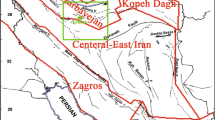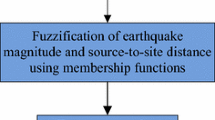Abstract
In this study, improvements to the earthquake location method were investigated using a fuzzy logic approach proposed by Lin and Sanford (Bull Seismol Soc Am 91:82–93, 2001). The method has certain advantages compared to the inverse methods in terms of eliminating the uncertainties of arrival times and reading errors. In this study, adopting this approach, epicentral locations were determined based on the results of a fuzzy logic space concerning the uncertainties in the velocity models. To map the uncertainties in arrival times into the fuzzy logic space, a trapezoidal membership function was constructed by directly using the travel time difference between the two stations for the P- and S-arrival times instead of the P- and S-wave models to eliminate the need for obtaining information concerning the velocity structure of the study area. The results showed that this method worked most effectively when earthquakes occurred away from a network or when the arrival time data contained phase reading errors. In this study, to resolve the problems related to determining the epicentral locations of the events, a forward modeling method like the grid search technique was used by applying different logical operations (i.e., intersection, union, and their combination) with a fuzzy logic approach. The locations of the events were depended on results of fuzzy logic outputs in fuzzy logic space by searching in a gridded region. The process of location determination with the defuzzification of only the grid points with the membership value of 1 obtained by normalizing all the maximum fuzzy output values of the highest values resulted in more reliable epicentral locations for the earthquakes than the other approaches. In addition, throughout the process, the center-of-gravity method was used as a defuzzification operation.














Similar content being viewed by others
References
Bodur, K. (2012). Fuzzy Logic Approach on Earthquake Locations, Master Thesis. The Graduate School of Natural and Applied Sciences, Karadeniz Technical University.
Bonham-Carter, G. F. (1994). Geographic information systems for geoscientists. Ottawa: Pergamon.
Edwards, R. A., Scott, C. L., Shillington, D. J., Minshull, T. A., Brown, P. J., & White, N. J. (2009). Wide-angle seismic data reveal sedimentary and crustal structure of the Eastern Black Sea. The Leading Edge, 28, 1056–1065.
Gökalp, H. (2012). Tomographic imaging of the Seismic Structure Beneath the East Anatolian Plateau Eastern Turkey. Pure and Applied Geophysics, 169, 1749. doi:10.1007/s00024-011-0432-x.
Hartse, H. E. (1991). Simultaneous hypocenter and velocity model estimation using direct and reflected phases from micro earthquakes recorded within the central Rio Grande rift, Ph. D. Dissertation, New Mexico Institute of Mining and Technology, Sorocco, New Mexico, 251 pp.
IEC. (1997a). Fuzzy control programming. Technical report, International Electro technical Commission.
IEC. (1997b). International Electrotechnical Commission, Technical Committee No. 65. Industrial Process measurement and Control, IEC 11131-7 CD1.
Jamshidi, M., Vadiee, N., & Ross, T. J. (1993). Fuzzy logic and control: Software and hardware applications. In M. Jamshidi (Ed.), Environmental and intelligent manufacturing systems (Vol. 3). Englewood Cliffs: Prentice Hall.
Kandel, A. (1986). Fuzzy Mathematical Techniques with Applications, Addison-Wesley, Reading, Massachusetts, 274 pp.
Klein, F.W. (1978). Hypocenter location program HYPOINVERSE, U.S. Geological Survey Open-File Report 78-694, 113 pp.
Lahr, J.C. (1980). HYPOELLIPSE: a computer program for determining local earthquake hypocentral parameters, magnitude and first motion pattern, U.S. Geological Survey Open-File Report 80-59, 59 pp.
Lee, W. H. K., & Lahr, J. C. (1975). HYPO71 (Revised): A computer program for determining hypocenter, magnitude, and first motion pattern of local earthquakes, U. S. Geol. Surv. Open file Rept. 75–311.
Lienert, B. R. (1997). Assessment of earthquake location accuracy and confidence region estimates using known nuclear tests. Bulletin of the Seismological Society of America, 87, 1150–1157.
Lienert, B. R., Berg, E., & Frazer, L. N. (1986). HYPOCENTER: An earthquake location method using centered, scaled, and adaptively least squares. Bulletin of the Seismological Society of America, 76, 771–783.
Lin, K., & Sanford, R. A. (2001). Improving regional earthquake using a modified G matrix and fuzz logic. Bulletin of the Seismological Society of America, 91, 82–93.
Marks II. R. J. (1994). Fuzzy logic technology and applications. IEEE Technology Update Series, pp. 19–24.
Mendel, J. (1995). Fuzzy logic systems for engineering: A tutorial. Proceedings of the IEEE, 83(3), 345–377.
Pavlis, G. (1992). Appraising relative earthquake location errors. Bulletin of the Seismological Society of America, 82, 836–859.
Şaroğlu, F., Emre, Ö., & Kuşçu, I. (1992). Active fault map of Turkey. Ankara: General Directorate of Mineral Research and Exploration.
Shillington, D. J., Scott, C. L., Minshull, T. A., Edwards, R. A., Brown, P. J., & White, N. (2009). Abrupt transition from magma-starved to magma-rich rifting in the eastern Black Sea. Geology, 37(1), 01–07.
Turkelli, N., Sandvol, E., Zor, E., Gok, R., Bekler, T., Al-Lazki, A., et al. (2003). Seismogenic zones in Eastern Turkey. Geophysical Research Letters, 30(24), 8039. doi:10.1029/2003GL01823.
Yager, R., & Zadeh, L. A. (Eds.). (1992). An introduction to fuzzy logic applications in intelligent systems. Boston: Kluwer.
Yanovskaya, T. B., Gobarenko, V. S., & Yegorova, T. P. (2016). Subcrustal structure of the Black Sea Basin from seismological data, Izvestiya. Physics of the Solid Earth, 52(1), 14–28.
Zadeh, L. A. (1965). Fuzzy sets. Information and Control, 8, 338–353.
Zimmermann, H. (1991). Fuzzy set theory and its applications. Englewood Cliffs: Prentice Hall.
Acknowledgements
The author would like to thank Dr. Tahir Serkan Irmak and anonymous reviewers who provided helpful comments that led to the improvement of the manuscript.
Author information
Authors and Affiliations
Corresponding author
Rights and permissions
About this article
Cite this article
Gökalp, H. Improvements to Earthquake Location with a Fuzzy Logic Approach. Pure Appl. Geophys. 175, 341–363 (2018). https://doi.org/10.1007/s00024-017-1688-6
Received:
Revised:
Accepted:
Published:
Issue Date:
DOI: https://doi.org/10.1007/s00024-017-1688-6




